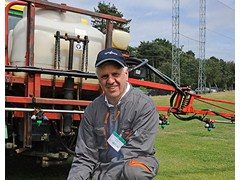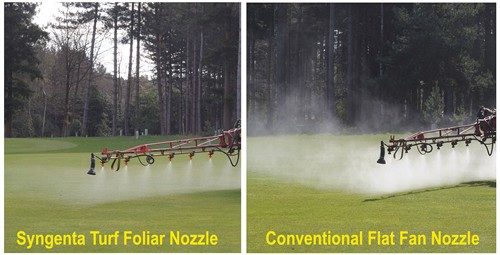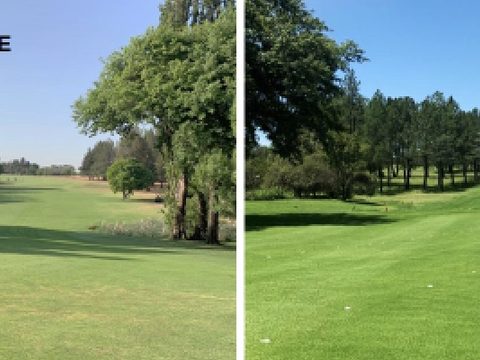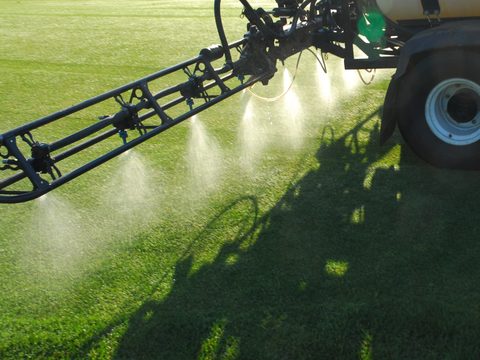Spray nozzle selection tips

Nozzle choice keeps sprays on target
As the final point of delivery, the choice of nozzle influences water volume, spray pressure, droplet size and distribution - all of which ultimately dictate spray coverage on the leaf and, most importantly, spray retention on the intended target.
All nozzles produce a spectrum of droplet sizes, but the proportion of small, medium and coarse droplets will vary. Large nozzles tend to produce more coarse drops, whilst small nozzles tend to produce more fine drops. Operators can use their choice of nozzle to tailor droplet size to the turf structure and the spray target.
Whilst the conventional flat fan nozzle can do a very acceptable job in most conditions, using the optimum nozzle for the job could make the all important difference between an acceptable 90% control, and an excellent 99% result.
The choice really depends on the target for the spray. Small droplets provide a greater leaf coverage for any given spray volume and are generally retained well on the leaf surface. When the droplet size is halved, the number of drops produced goes up by a factor of eight, and the coverage of the leaf may be up to four times greater.
Drift control
The problem is that fine droplets are more difficult to control and more likely to result in drift. Dense, fine turf is a very flat, uniform surface with little internal air movement, which makes it a difficult target. Fine droplets just hover above the surface in a boundary layer of air; if there is any wind they can drift off.
Spraying on a still summer evening, when there may be upward thermal currents from the warm soil, these fine droplets can easily be lifted up and carried off - which is another reason why spraying early in the morning is often preferred, and results when there is just a little air movement can be more effective than very still conditions.
If you are spraying longer grass - such as areas of rough around the golf course or some amenity situations - then the canopy can create its own vortex, which effectively sucks down the spray droplets.
Turbulence generated by the sprayer itself is also generally bad news. If you double the forward speed the turbulence is increased by a factor of four, which may make it harder for small droplets to break out of the air flow and land on the target. It is a factor to consider when moving to faster forward speeds.
In general, you will be able to go faster and in a wider range of conditions with nozzles producing larger droplets, as there is less risk of turbulence and drift. Larger drops also have greater velocity to improve penetration of dense turf. So if you are looking to target disease pathogens at the soil surface, for Take All or Fairy Ring for example, and for liquid fertilisers they may be an ideal choice.
In the past, the velocity of large droplets has resulted in droplets literally bouncing off the target or running off over-wet leaves, especially at higher water volumes. This has been bad news for the efficacy of fungicide products, particularly contacts. However, the advent of air induction nozzles, that incorporate tiny air bubbles within each droplet that act as 'shock-absorbers', helps the larger drops land gently on the leaf and spread to give good coverage, rather than bouncing off. Good product formulation, with the correct blend of surfactants and adjuvants, ensures good coverage of the leaf and minimal run-off.

Water volume
We also know that foliar fungicides can perform equally well, if not better, when applied at a water volume of 200 l/ha, compared to 600 or 800 l/ha traditionally used in some situations. This could further enhance the potential of new air-induction nozzles and make them an especially good option for foliar fungicide and PGR applications.
One further benefit of reducing water volume is that it saves time and you can get around the course quicker to minimise disruption to players. If you could do all your greens on one tank fill, for example, that might save an hour and enable you to finish before the course gets busy. For spraying larger fairways and rough areas it could make a significant difference.
Faster application also means products can be applied closer to the optimum time, ensuring you can achieve the best possible results. Trials have shown the ideal time for most fungicide applications is after there has been a high risk of disease pathogens landing on the leaf, but before spores have germinated and penetrated the surface to cause any damage.
Nozzle research
In the UK, Syngenta is currently undertaking trials at the STRI, along with greenkeepers and turf managers, to evaluate and assess turf specific designs and recommendations for new nozzle options, coupled with the selection of the appropriate water volumes and application at the optimum time, turf managers could further improve disease control and turf quality in the future.
Key points for nozzle selection:
- Change nozzles to match spray target and conditions
- Air induction nozzles can reduce risk of spray drift
- Leaf coverage is important for contact foliar fungicides
- High velocity nozzles can increase penetration through dense turf
- Reduced water volume can improve timeliness of applications





